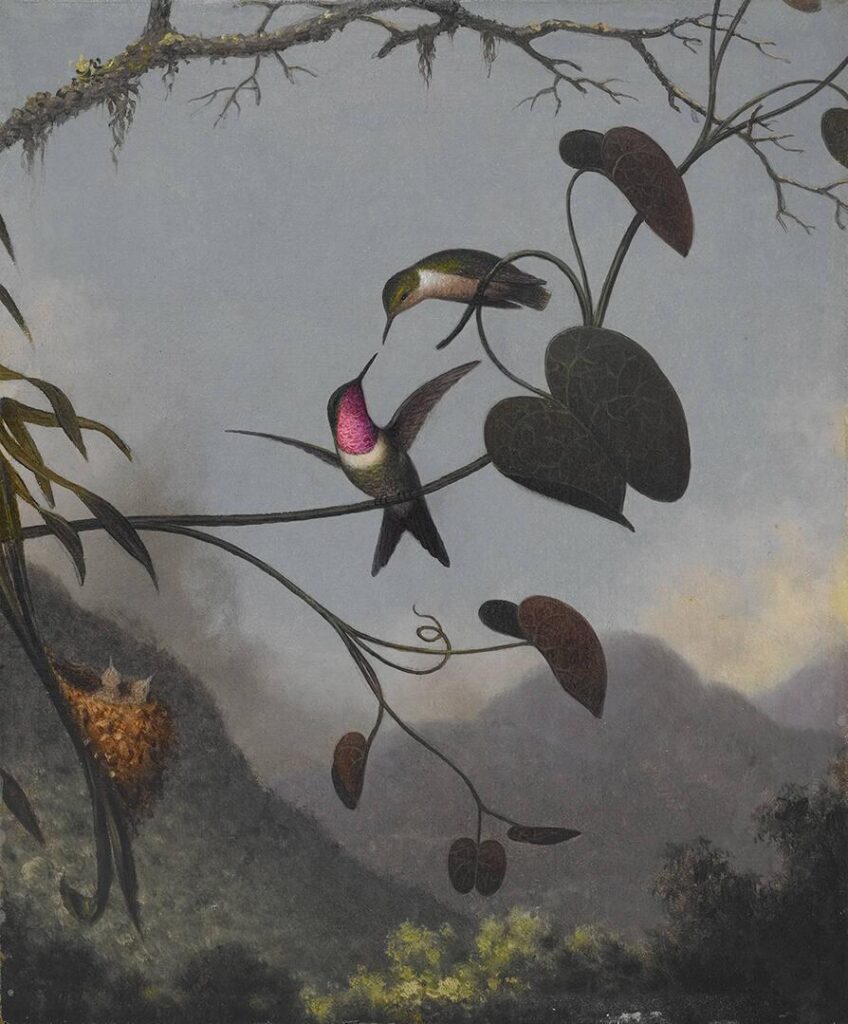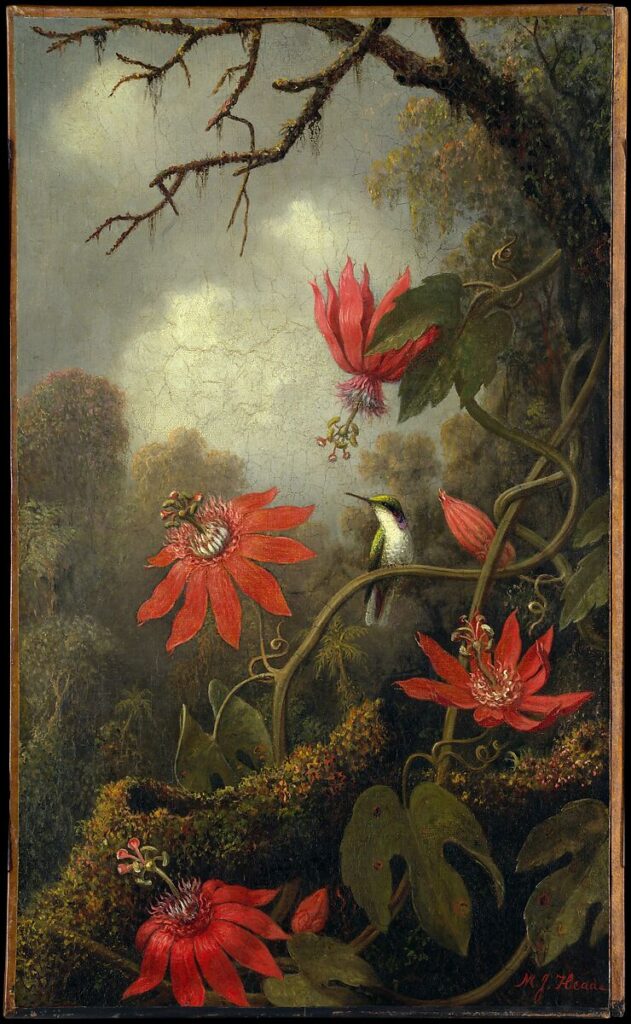The Humming-Bird
By Comte de Buffon, translated by Daniel Alexander Payne (Bishop Payne)
Annotations by Rene Marzuk

Beautiful and useful translations from the French of Buffon. By BISHOP PAYNE. [Original byline in the Repository of Religion and Literature, and of Science and Art.]
Of all animated beings, behold the most elegant in form and the most brilliant in colors. The stones and the metals polished by our art, are not comparable to this jewel of nature: in the order of birds she has placed it, in the last degree of the scale of size; her master-piece is the little humming-bird: she has overwhelmed her, with all the gifts she has divided among other birds; lightness, rapidity, swiftness, grace, and rich attire, all appertain to this little favorite.[1] The emerald, the ruby, the topaz, glitter upon its robes: it never soils them with the dust of the earth, and in its life all aereal, one hardly sees it touch the grass by moments; it is always in the air, flying from flower to flower, it has their freshness, as it has their brilliance; it lives upon their nectar, and it dwells in climates, where, without ceasing, it renews itself.
It is in the warmest countries of the New World, where one finds all the species of the humming-birds; they are very numerous, and appear to be confined between the two tropics; for those of them that advance into the temperate zones, there may be but a short sojourn: they seem to follow the movements of the sun, to advance, and to retire with him, and to fly upon the wings of zephyrs, in the retinue of an eternal spring.[2]
The Indians, smitten by the splendor of the fire which radiate from the colors of these brilliant birds, have given to them the name of rays and hues of the sun.[3] The smallest species of these birds are less than the ox-fly in length, and the drone-bee in thickness. [4] Their bill is like a fine needle, and their tongue, as a delicate thread; their little black eyes appear as just two brilliant points; the plumes of their wings are so delicate, that they appear transparent. Their feet are so short and small, that one with difficulty perceives them; they make but little use of them; they only set them down to sleep during the night, and during the day keep them pendant in the air; their flight is continuous, rapid, and humming; and some one has compared the noice of their wings to that of a spinning-wheel. Their clapping is so swift, that the bird in the air, stopping itself, appear not only immoveable, but all at once without action. One may see it thus arrest itself for a few moments before a flower, and then to dart from it like an arrow to another; it visits all; plunges its little tongue into their bosoms; caressing it with its wings, without alighting upon them, but also without ever quitting them.
He passes his inconstancies, but for the better to follow his loves, and to multiply its innocent enjoyments; for this lover, by slighting its flowers, lives at their expense, without withering them. He does but pump their honey, and it is to this use that his tongue seems to be so uniquely destined, it is composed of two hollow fibres, forming one little canal, divided at the end into two fillets; it has the form of a proboscis, and performs the functions of that instrument; the bird darts it out of his bill and plunges it into the bottom of the cup of the flowers, and thus extracts the nectar from them. Nothing equals the vivacity of these little birds, if it be not their courage, or rather, their audacity. One may often see them pursuing, with fury, some birds twenty times their size, attaching themselves to their bodies, and alluring them to carry them in their flight, peck them with repeated blows.[5]
Impatience seems to be their soul; if they approach a flower, and find it withered, they pluck out its petals, with a precipitation that marks its spite. The nest which they construct, respond to the delicacy of their bodies; it is made either of fine cotton or a silken hair, gathered from certain flowers; this nest is strongly tissued, and of the consistence of a soft and downy skin; the female charges herself with the work, and leave to the male the care of bringing the materials. One may see her at this cherished work, seeking, choosing, employing, blade by blade, such fibres as are proper to form the tissue of that soft cradle, which is designed for its progeny. She polishes the borders of it with her neck, and the interior with her tail; she coats it on the outside with little pieces of the bark of resinous plants, which she glues around it, to defend it from the injuries of the air, so as to render it more solid; the whole is attached to two leaves, or to a single blade of the orange or citron tree; or sometimes to a straw which hangs at the eves of a cottage. This nest is no bigger than the half of an apricot, and formed like a half cup. One there finds two eggs all white, and no larger than little peas, The male and the female cover them by turns, during twelve days; the little ones are hatched on the thirteenth, and are then no larger than some flies. “I have never been able to discover,” says P. Durterte, “what kind of billfull the mother gives them, only that she gives them her tongue to suck, while yet it is enameled with the sugar drawn from the flowers.” [6]

BUFFON (TRANSLATED BY BISHOP PAYNE). “THE HUMMING-BIRD.” REPOSITORY OF RELIGION AND LITERATURE, AND OF SCIENCE AND ART’S VOL. III, NO. 3 (JULY 1861): 122-4.
[1] “. . . in the last degree of the scale of size”: The Bee Hummingbird, which can be found in Cuba, is not only the smallest hummingbird, but also the smallest bird in the world.
[2] “It is in the warmest countries of the New World . . .”: There are almost 340 species of hummingbirds in the world, all of them occurring, in fact, in the American continent.
[3] “Indians,” in this case, refers to members of the Indigenous tribes of America. See “The Impact of Words and Tips for Using Appropriate Terminology: Am I Using the Right Word?”
[4] The ox-fly, also known as warble fly, refers to a kind of large flies that lay their eggs on mammals. A drone-bee is a male honey bee.
[5] Hummingbirds can be aggressive and territorial. Males will usually fight each other to assert their breeding grounds. Interestingly, the symbols of authority of Huitzilopochtli, the Aztec god of sun and war, are the hummingbird and fire. In fact, Huitzilopochtli means “blue hummingbird on the left.”
[6] Female hummingbirds regurgitate their food to feed their young.
The Repository of Religion and Literature, and of Science and Arts was a short-lived (1858-63) quarterly for Black children published by a group of African Methodist Episcopal (A.M.E.) societies. Bishop Daniel Alexander Payne (1811-1893), who translated “The Humming-Bird,” was one of the magazine editors and a main figure in the A.M.E. He was also an educator, administrator, and author. George-Louis Leclerc, Comte de Buffon (1749-1788), was an influential French naturalist.
Definitions from Oxford English Dictionary:
aereal: Aerial. Dwelling, flying, or moving in the air, above the earth; occurring or taking place in the air; (spec. of birds or bats) spending much of the time airborne.
appertain: To belong as parts to the whole, or as members to a family or class, and hence, to the head of the family; to be related, akin to.
proboscis: Any of various elongated, tubular, and usually flexible mouthparts of insects, used for sucking liquids and sometimes for piercing, as in bees, flies, mosquitoes, bugs, and butterflies and moths (in which it is coiled when not in use).
progeny: Offspring, issue, children; descendants. Occasionally: a child, a descendant; a family.
Resources for Further Study
- Visit BlackPast to learn more about Daniel Alexander Payne.
- Interactive experience designed to accompany a 2020 exhibition about Martin Johnson Heade’s hummingbird paintings. Courtesy of the Crystal Bridges Museum of American Art (Bentonville, AR).
Contemporary Connections
Learn how to keep your backyard hummingbird-friendly!